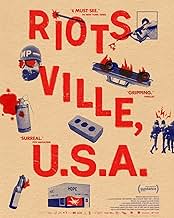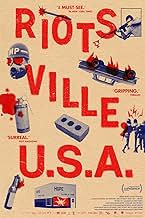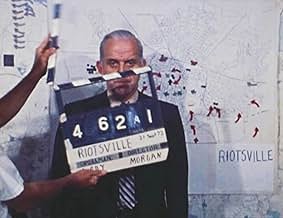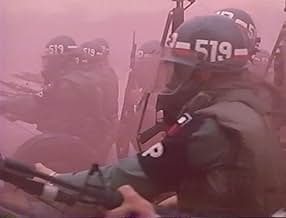Welcome to Riotsville, a fictional town built by the US military. Using all archival footage, the film explores the militarization of the police and creates a counter-narrative to the nation... Read allWelcome to Riotsville, a fictional town built by the US military. Using all archival footage, the film explores the militarization of the police and creates a counter-narrative to the nation's reaction to the uprisings of the late '60s.Welcome to Riotsville, a fictional town built by the US military. Using all archival footage, the film explores the militarization of the police and creates a counter-narrative to the nation's reaction to the uprisings of the late '60s.
- Awards
- 4 wins & 10 nominations total
Charlene Modeste
- Voiceover
- (voice)
Lyndon B. Johnson
- Self
- (archive footage)
Otto Kerner
- Self - Chairman
- (archive footage)
- (as Governor Otto Kerner)
Edward P. Morgan
- Self - PBL Chief Correspondent
- (archive footage)
Robert Curvin
- Self - Former Chairman, Neward CORE
- (archive footage)
Leonard Kowalewski
- Self - Newark Police
- (archive footage)
John Harrington
- Self - Fraternal Order of Police
- (archive footage)
- (as Sgt. John Harrington)
Albert Cleage
- Self
- (archive footage)
- (as The Rev. Albert Cleage)
Alvin F. Poussaint
- Self - Tufts University
- (archive footage)
- (as Dr. Albert Poussaint)
Fred Harris
- Self - Commission Member
- (archive footage)
- (as Sen. Fred R Harris)
Dick Gregory
- Self
- (archive footage)
Roger Mudd
- Self
- (archive footage)
Robert Byrd
- Self
- (archive sound)
- (as Senator Robert Byrd)
Jimmy Collier
- Self
- (archive footage)
Frederick Douglass Kirkpatrick
- Self
- (archive footage)
- (as Rev. Frederick Douglass Kirkpatrick)
Ronald Reagan
- Self
- (archive footage)
Spiro Agnew
- Self
- (archive footage)
- (as Gov. Spiro Agnew)
Strom Thurmond
- Self
- (archive footage)
- (as Sen. Strom Thurmond)
- Director
- Writer
- All cast & crew
- Production, box office & more at IMDbPro
Featured reviews
It's unfortunate when a film has an important message to convey but does a poor job of saying what it has to say. That's the problem with this documentary about the policies and practices underlying government efforts to control violent civil disobedience in major US cities during the mid to late 1960s. It focuses on the training programs employed at US Army bases where model cities (called "Riotsville") were built to stage simulated disturbances used for instructing military and police forces on how to quell such outbreaks in line with official government policies. But the film goes beyond that, trying to explain why these incidents were occurring with increasing frequency at the time and why such extensive training measures had become necessary. In doing so, the picture examines the frustrations associated with, and subsequent reactions to, the issues of poverty, racism, police brutality, inequality and the impact of the Vietnam War, among others, principally in minority inner city communities. It tells this story using only archive footage from the time, drawn from television broadcasts and official US military training films. However, given the broad scope of this story, director Sierra Pettengill's third feature outing doesn't delve nearly deep enough into these issues, somewhat surprising given the wealth of material at the filmmaker's disposal. Nor does it tie the Riotsville project to these larger questions as well as it could, relying more on implication than connection. Moreover, this shallow, underdeveloped approach is further undercut by a number of poorly chosen video segments and others in desperate need of editing out extraneous content. Add to that far too many explanatory subtitles and a number of dull, overwritten voiceovers seeking to philosophically elaborate on its conclusions, and you've got a watered down presentation of material deserving to be delivered with a greater sense of hard-hitting urgency. This is the sort of film that should make audiences angry, not put them to sleep, but this offering does more to promote the latter than the former. This is a story that would have been better told through more skillful directorial hands for it to have the impact it requires. Unfortunately, that's not the case here.
I was excited to see this documentary when I first heard about it and sought it out, but in the end it left me bored and annoyed.
The director has access to some remarkable file footage, but doesn't seem to know what to do with it. Interspersed with that amazing footage are a series of overly arty flashing collages of ambient video (a close up of TV pixels for several minutes) coupled with grinding tuneless soundscapes and a laughable voice over that sounds like a cross between a bad poetry slam and a hilarious satire of an overly earnest podcast, right down to the slow, labored delivery and over-pronunciation (Think the "You Must Remember This" podcast)
The director also made a weird choice to not have voice narration outside of the arty collages; instead she has chosen like a hundred title cards in black rectangles in the middle of the screen. It becomes annoying pretty quickly since the file footage is so jaw droppingly interesting.
So many bad choices directorially. With the footage they had, this should have been a gimme, instead it's like a high school film students senior project with a fairly dumbed-down historical take.
Come for file footage; be prepared to fast forward through the long, boring "podcast" segments.
The director has access to some remarkable file footage, but doesn't seem to know what to do with it. Interspersed with that amazing footage are a series of overly arty flashing collages of ambient video (a close up of TV pixels for several minutes) coupled with grinding tuneless soundscapes and a laughable voice over that sounds like a cross between a bad poetry slam and a hilarious satire of an overly earnest podcast, right down to the slow, labored delivery and over-pronunciation (Think the "You Must Remember This" podcast)
The director also made a weird choice to not have voice narration outside of the arty collages; instead she has chosen like a hundred title cards in black rectangles in the middle of the screen. It becomes annoying pretty quickly since the file footage is so jaw droppingly interesting.
So many bad choices directorially. With the footage they had, this should have been a gimme, instead it's like a high school film students senior project with a fairly dumbed-down historical take.
Come for file footage; be prepared to fast forward through the long, boring "podcast" segments.
But this was far below what i expected from a historical perspective. Its the black and white stigmata over and over again, and what really should be delved with, namely how antiriot enforcement where thought to be and how it came to be in the name of riotsville usa drowns in a claustrophobic, cataclysmic psychedelic epileptic triggering lightshows and overfocused still, and a neoneoneoultra composed musical scored( like norwegian composer arne nordheim) makes this a complete rotten mess historywise. Its narrative voice never tells how much was spended or how large this antiriotforce buildup was, and the real riots that couldve made this documentary a real document of history lacks completely.
So if this is how riots have been handled over the years then its time to look somewhere else. As a filmproduct it lacks quality on most bases, and the amount of positive criticism over a ribbed and untelling way to tell a story that has been told here really feels fictitious. The grumpy old man doesnt recommend this one, and will cry out a call to the big documentarymakers to make a series about the real rioting 60's and the real face of the crammed crow.
So if this is how riots have been handled over the years then its time to look somewhere else. As a filmproduct it lacks quality on most bases, and the amount of positive criticism over a ribbed and untelling way to tell a story that has been told here really feels fictitious. The grumpy old man doesnt recommend this one, and will cry out a call to the big documentarymakers to make a series about the real rioting 60's and the real face of the crammed crow.
Violent police repression as a first response tactic against protests, still seems to dominate todays American society as much as it did during the sixties.
This eyeopening documentary gives us a surprisingly detailed insight into how authorities reacted to the first mass race riots and civil rights protests during the sixties.
This documentary has got lots of interesting LIVE public television footage about racism and inequality and police brutality and it uses a police training video for how to handle riots as a red line through this entire movie about how the goverment responded to civil rights protests and race riots during the sixties.
In general the government did 2 things to "respond" to the protests and race riots:
1.
The authorities investigated the cause of race riots during the sixties by appointing a commision of conservatives who came to a similar conclusion as the African American people who were protesting, namely that American society was brutally split and full of inequality and racism.
2.
Shocked by this unwelcome outcome of the conservative comission the government only accepted one tiny subconclusion out of the entire comission's report and that was to give the police more weapons to repress riots...
This documentaries' strength lies in the abstract narration and style. Because of that style the total oblivion of goverment officials becomes even more painfully clear for all to see...
I have seen several documentaries about racism and police brutality lately and this is the one that got me thinking the most about the world of total oblivion that politicians are wallowing in...
This eyeopening documentary gives us a surprisingly detailed insight into how authorities reacted to the first mass race riots and civil rights protests during the sixties.
This documentary has got lots of interesting LIVE public television footage about racism and inequality and police brutality and it uses a police training video for how to handle riots as a red line through this entire movie about how the goverment responded to civil rights protests and race riots during the sixties.
In general the government did 2 things to "respond" to the protests and race riots:
1.
The authorities investigated the cause of race riots during the sixties by appointing a commision of conservatives who came to a similar conclusion as the African American people who were protesting, namely that American society was brutally split and full of inequality and racism.
2.
Shocked by this unwelcome outcome of the conservative comission the government only accepted one tiny subconclusion out of the entire comission's report and that was to give the police more weapons to repress riots...
This documentaries' strength lies in the abstract narration and style. Because of that style the total oblivion of goverment officials becomes even more painfully clear for all to see...
I have seen several documentaries about racism and police brutality lately and this is the one that got me thinking the most about the world of total oblivion that politicians are wallowing in...
Greetings again from the darkness. A couple of old sayings came to mind while watching this. "The more things change, the more they stay the same." This ties together what we see from the 1960's with what we've seen very recently in the U. S. Next would be, "You made your bed, now sleep in it." This references the manner in which our government reacted to civil unrest in the 1960s has affected our society for the past 50+ years.
Documentarian Sierra Pettingill utilizes only archival footage from TV (newscasts and talk shows) and military footage filmed during the era. The clips are edited in a way to tell the story of how the government responded to increased civil unrest, and how those responses not only made the situation worse, it also set the table for ongoing societal issues for decades to come.
Historical background includes President Lyndon Johnson forming the Kerner Commission (officially The National Advisory Commission on Civil Disorders), and how the resulting 700 page 1968 report did not provide the conclusions expected by the government. It warned of two societies - one white, one black, separate and unequal. The corresponding action items were deemed too expensive due to the ongoing Vietnam War. Instead an addendum suggested expanded federal funding for police ... that one hit home with politicians.
Much of the footage, as well as the film's title, comes from the model town constructed by the military at Fort Belvoir in Virginia. It's here where training sessions occurred with military personnel cast as rioters and law enforcement learned the approaches to quell the uprising. Unfortunately, most of these approaches involved law enforcement escalation during civil unrest, leaving us wondering which causes the most damage. We even see military leaders observing the drills from the grandstands, applauding and laughing in some parts. It's impossible not to notice that these are all white faces.
Further escalation and federal funding resulted in specialty tanks, and we see the training videos around this weapon. At its core, what we see is a simulated riot in a simulated city. It's easy to view this as training hate and power, rather than learning de-escalation techniques. Director Pettingill also includes clips from PBL (precursor to PBS) talk shows like "Civil Disorder". These shows, and their debates, caused Ford Motor Company to withdraw funding in 1969. The news clips from the 1968 Democrat and Republican conventions provide some insight into the reporting during this era. Especially biting is David Brinkley's response to Strom Thurmond's comments. The film's only weakness comes in the form of narration from Charlene Modeste. The words are simply too flowery or artsy for such subject matter. This is a film that urges you to feel the frustrations. It turns out "Law & Order" can be twisted by those in power.
Releasing in theaters and OnDemand beginning September 16, 2022.
Documentarian Sierra Pettingill utilizes only archival footage from TV (newscasts and talk shows) and military footage filmed during the era. The clips are edited in a way to tell the story of how the government responded to increased civil unrest, and how those responses not only made the situation worse, it also set the table for ongoing societal issues for decades to come.
Historical background includes President Lyndon Johnson forming the Kerner Commission (officially The National Advisory Commission on Civil Disorders), and how the resulting 700 page 1968 report did not provide the conclusions expected by the government. It warned of two societies - one white, one black, separate and unequal. The corresponding action items were deemed too expensive due to the ongoing Vietnam War. Instead an addendum suggested expanded federal funding for police ... that one hit home with politicians.
Much of the footage, as well as the film's title, comes from the model town constructed by the military at Fort Belvoir in Virginia. It's here where training sessions occurred with military personnel cast as rioters and law enforcement learned the approaches to quell the uprising. Unfortunately, most of these approaches involved law enforcement escalation during civil unrest, leaving us wondering which causes the most damage. We even see military leaders observing the drills from the grandstands, applauding and laughing in some parts. It's impossible not to notice that these are all white faces.
Further escalation and federal funding resulted in specialty tanks, and we see the training videos around this weapon. At its core, what we see is a simulated riot in a simulated city. It's easy to view this as training hate and power, rather than learning de-escalation techniques. Director Pettingill also includes clips from PBL (precursor to PBS) talk shows like "Civil Disorder". These shows, and their debates, caused Ford Motor Company to withdraw funding in 1969. The news clips from the 1968 Democrat and Republican conventions provide some insight into the reporting during this era. Especially biting is David Brinkley's response to Strom Thurmond's comments. The film's only weakness comes in the form of narration from Charlene Modeste. The words are simply too flowery or artsy for such subject matter. This is a film that urges you to feel the frustrations. It turns out "Law & Order" can be twisted by those in power.
Releasing in theaters and OnDemand beginning September 16, 2022.
- How long is Riotsville, U.S.A.?Powered by Alexa
Details
- Release date
- Country of origin
- Official site
- Language
- Also known as
- Riotsville, USA
- Production companies
- See more company credits at IMDbPro
Box office
- Gross US & Canada
- $40,960
- Opening weekend US & Canada
- $5,597
- Sep 18, 2022
- Gross worldwide
- $44,392
- Runtime1 hour 31 minutes
- Color
Contribute to this page
Suggest an edit or add missing content














